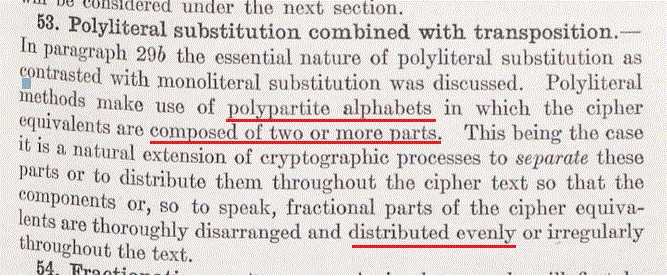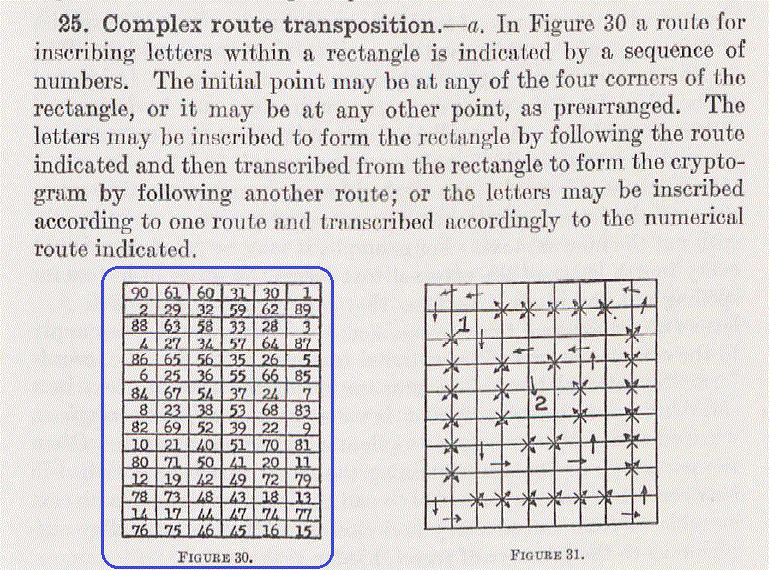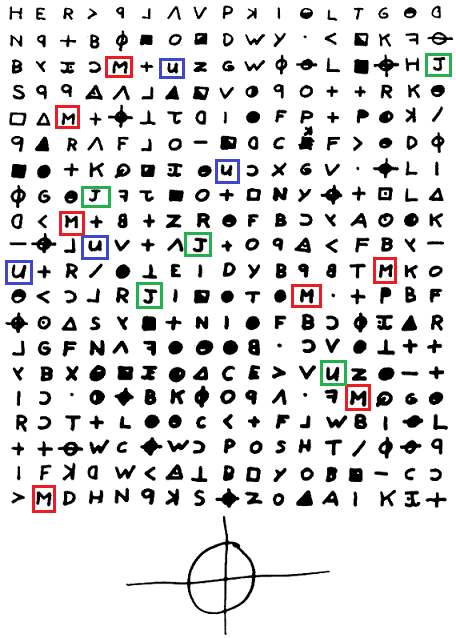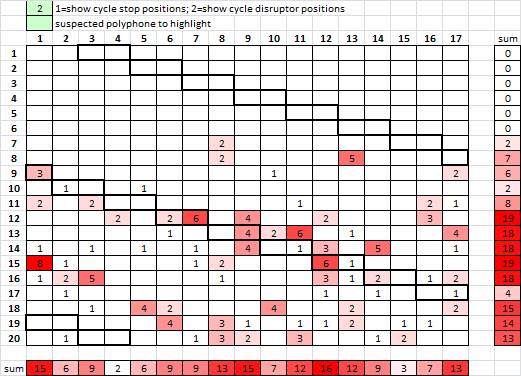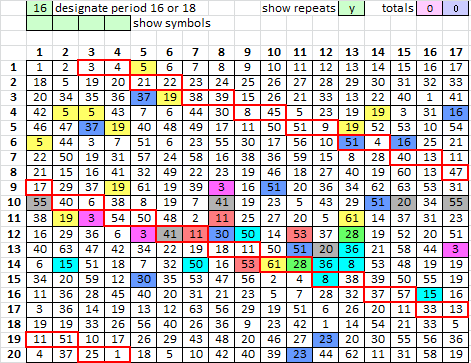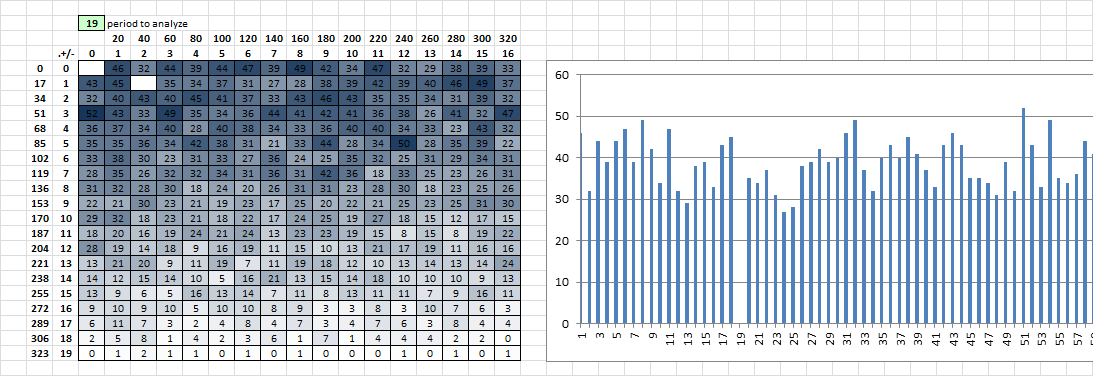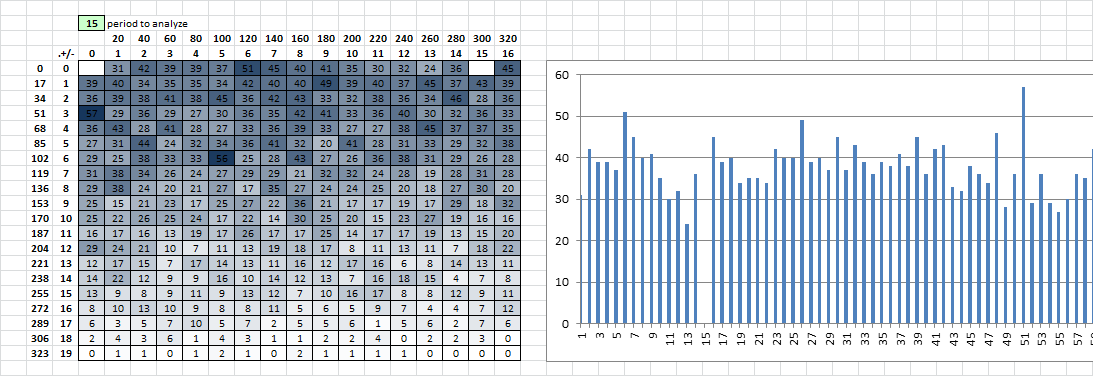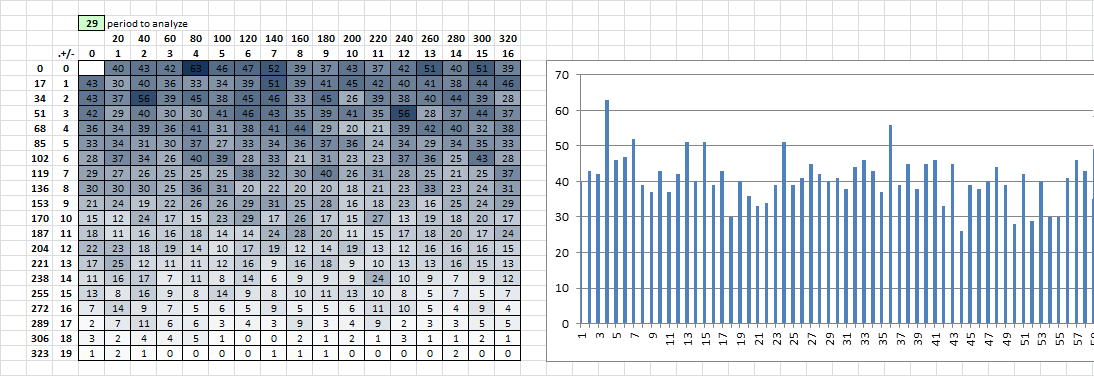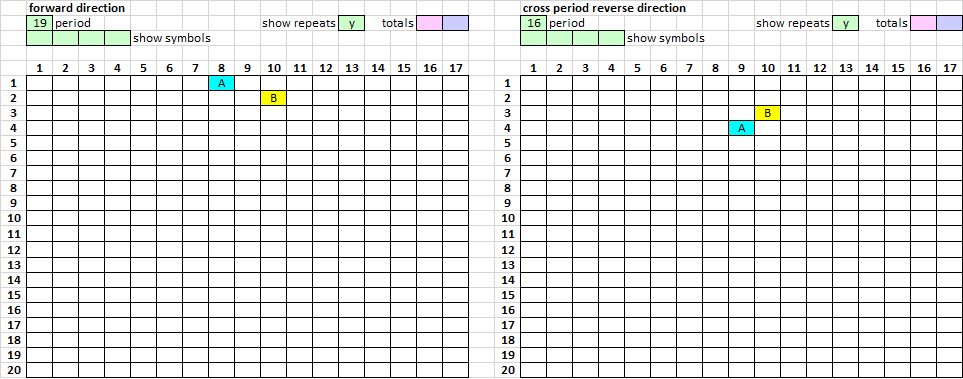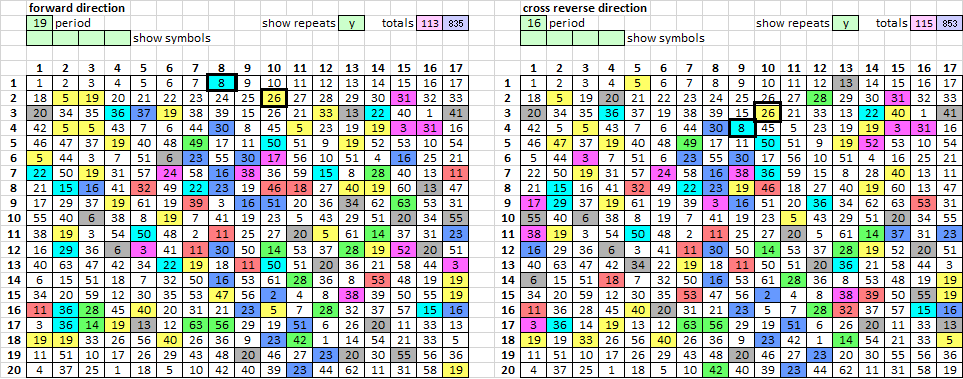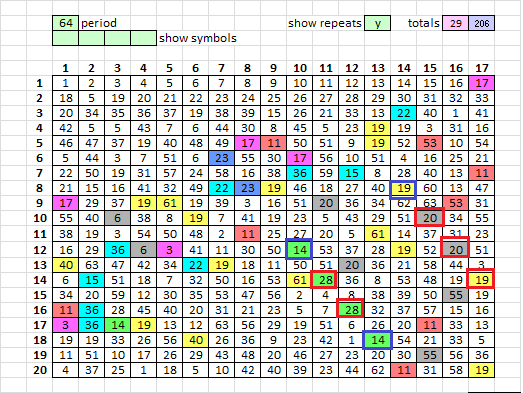And smokie, sorry for leaving you in the dust a bit. I use mostly all of your of ciphers on a regular basis and I am sure that all the new transposition ciphers you have created will go a long way. I will get back on the transposition solver eventually.
No problem. I am still working on it. This weekend I made a spreadsheet that finds two period trigrams ( e.g. A 29 B 15 C ), and have started to consider other transposition variations. Different geometric shapes and other ideas. I feel that the pivots are probably very important, that he left them as a clue. He liked to do stuff like that. I am working on looking at the message more. Finding what I can find. I made another cross period and reverse cross period detector. I found this interesting pattern. Period 29, followed by period 15 and another period 15. There are only two of the X symbol in the whole message and they are both involved. There are only three of the circle with the dot inside and two of them are involved. I think that we already knew about the two trigrams, but add to that period 29 with the upside down T I find interesting. There are only four of the upside down T, and two of the four are involved.
Polyliteral substitution combined with transposition
I have been skimming through the War Department Technical Manual TM 11-485 Advanced Military Cryptography. It is excellent and full of variations of classical ciphers. There is a good section on transposition much more detailed than in other books, and also combined substitution transposition.
http://radionerds.com/images/b/bb/TM_11-485.pdf
Here is something that I have thought of recently, it was in the book. This is not a description of bifid, which comes later in the book. Basically one plaintext becomes two ciphertext which are separated somehow. A message with 340 symbols would only be 170 plaintext. Page 73 of the Manual, 74 of the website.
Page 39 in the book starts with a big section on miscellaneous transpositions. Here is discussion of complex route transposition, and it uses a matrix similar to the ones that we have been making. A matrix + homophonic, based on reading through this manual, is entirely possible. What I really need to find is an example of just that.
About bifid and polyliteral,
I wonder if some encoding prior to homophonic substitution that changes the number of letters/symbols and the frequency distribution thereof would affect the unique sequence lengths (of which the 340 has 26 length 17 repeats).
My progress with assembler is going well. I managed to convert a performance crucial piece of the AZdecrypt algorithm to inline assembler. Though, it turned out a bit slower than the optimized code FreeBASIC outputs. However I can now start thinking of optimizing my assembler code and will be looking if something clever can be done with interesting instructions such as MMX and etc.
About bifid and polyliteral, I wonder if some encoding prior to homophonic substitution that changes the number of letters/symbols and the frequency distribution thereof would affect the unique sequence lengths (of which the 340 has 26 length 17 repeats).
I had to think about your question for a while before it made sense to me. I think that you may be right. Bifid flattens out the frequency distribution, somewhat. With flatter frequency distribution, there would be fewer Es to encode with the homophonic symbols. Thus the Es may be farther apart, and depending on how cyclic the encoding is, the unique sequence lengths may be longer.
EDIT: Here is a link to my bifid experiments: viewtopic.php?f=81&t=2617&p=47397&hilit=bifid#p47397
Smokie31
34 51 35 45 53 42 10 36 37 49 57 24 13 38 52 43 54
46 39 22 1 44 26 14 60 19 23 2 20 31 40 32 53 1
17 7 39 61 27 58 42 40 8 49 59 21 39 62 11 50 26
57 48 49 58 4 19 41 48 50 15 33 51 5 48 28 6 12
49 1 4 39 47 5 2 20 54 29 34 31 37 40 43 53 8
33 14 39 59 55 57 41 38 50 50 7 25 6 18 16 3 17
14 8 33 48 9 4 10 5 29 39 15 22 45 58 18 60 47
47 39 59 24 49 43 36 39 42 13 11 17 63 34 39 6 43
45 7 35 44 4 46 28 61 23 42 37 36 1 39 12 21 39
33 25 27 39 34 38 51 29 43 30 50 48 47 57 39 37 51
22 41 23 54 39 28 39 27 16 18 27 21 32 15 45 6 29
48 15 35 39 47 56 33 38 40 57 53 17 62 46 49 59 24
48 44 29 37 40 18 42 2 23 15 48 9 14 10 2 39 45
6 46 28 60 25 26 19 39 20 41 36 63 15 31 24 12 39
41 47 10 39 25 36 38 24 61 25 19 40 39 1 32 11 40
10 29 57 33 12 43 39 21 27 54 13 15 30 37 32 13 22
39 56 9 56 52 33 38 58 49 41 59 45 35 39 24 26 23
16 44 50 2 3 7 33 48 39 11 27 42 4 27 28 59 61
47 61 49 58 55 40 56 36 41 39 45 55 48 60 62 43 1
5 48 15 1 40 4 12 28 12 23 39 39 34 8 7 10 7
MUJ only on odd positions and cycle in top half of message
Thought for the day. Symbols 37, 38 and 41 only fall on odd positions, and they cycle with each other in the top half of the message. This still intrigues me.
In the prior thread, we worked on this as possible two keys, one for odd positions and one for even positions. However, I still think about these three symbols and the odd even phenomenon, which I don’t fully understand. The repeat symbols at periods 15 or 19 would fall on both odd and even positions, implying that there are not odd even keys. Is there a way to reconcile? Is there a way to rearrange the message so that we get these symbols on all odd or even positions, but have the repeats fall only on odd or even positions, then separate the odds and evens and untranspose?
It has been said that Zodiac wouldn’t have transposed the plaintext, then encoded, the again rearranged the message because that would be too much work. But I leave out no possibility. Could a combination of odd even keys, with transposition, cause unique symbol string lengths to get longer?
EDIT: I redrafted the 340 into 20 columns, and rotated it at 90 degrees. The grey shaded cells are odd, and the bold red font shows symbols 37, 38 and 41. Those symbols now fall on both even and odd positions. I was hoping that they would all fall on either even or odd, but they do not.
One way to detect multiple periodical keys is to look at periodical transposition with a cycle measurement. And also notice sub peaks at multiples.
My 2-symbol cycles measurement (inspired by smokie’s system):
smokie6, 2 periodical keys:
Periodical: (transposition, untransposition) -------------------------------------------------- Period 1: 1847, 1847 Period 2: 1620, 2025 <--- Period 3: 1643, 1366 Period 4: 1395, 1628 Period 5: 1531, 1276 Period 6: 1394, 1421 Period 7: 1246, 1365 Period 8: 1221, 1459 Period 9: 1401, 1268 Period 10: 1441, 1391 Period 11: 1336, 1214 Period 12: 1214, 1314 Period 13: 1134, 1260 Period 14: 1234, 1412 Period 15: 1386, 1486 Period 16: 1505, 1154 Period 17: 1543, 1527 Period 18: 1447, 1229 Period 19: 1259, 1471 Period 20: 1527, 1543
smokie7, 3 periodical keys:
Periodical: (transposition, untransposition) -------------------------------------------------- Period 1: 1598, 1598 Period 2: 1348, 1510 Period 3: 1329, 2265 <--- Period 4: 1259, 1473 Period 5: 1372, 1303 Period 6: 1159, 1566 Period 7: 1277, 1136 Period 8: 1218, 1272 Period 9: 1330, 1184 Period 10: 1181, 1187 Period 11: 1245, 1291 Period 12: 1271, 1524 Period 13: 1317, 1439 Period 14: 1328, 1185 Period 15: 1138, 1426 Period 16: 1295, 1142 Period 17: 1324, 1122 Period 18: 1348, 1074 Period 19: 1170, 1349 Period 20: 1122, 1324
340, unknown:
Periodical: (transposition, untransposition) -------------------------------------------------- Period 1: 2137, 2137 <--- Period 2: 1855, 1590 Period 3: 1251, 1324 Period 4: 1278, 1239 Period 5: 1278, 1110 Period 6: 1175, 975 Period 7: 1290, 1047 Period 8: 1261, 1155 Period 9: 1028, 1331 Period 10: 1323, 959 Period 11: 1367, 1227 Period 12: 1281, 1008 Period 13: 1130, 1190 Period 14: 965, 1151 Period 15: 1194, 1082 Period 16: 1321, 1133 Period 17: 1112, 1335 Period 18: 1111, 1181 Period 19: 1174, 1065 Period 20: 1335, 1112
408, one key:
Periodical: (transposition, untransposition) -------------------------------------------------- Period 1: 2871, 2871 <--- Period 2: 1788, 1801 Period 3: 1314, 1567 Period 4: 1307, 1238 Period 5: 1388, 1404 Period 6: 1063, 1409 Period 7: 1153, 952 Period 8: 1161, 1127 Period 9: 1252, 1269 Period 10: 1180, 1297 Period 11: 1069, 1343 Period 12: 1098, 1200 Period 13: 1034, 1026 Period 14: 1237, 1407 Period 15: 1135, 1357 Period 16: 1108, 932 Period 17: 1064, 1229 Period 18: 1152, 1186 Period 19: 1292, 1203 Period 20: 1122, 1203
Message redrafted into 19 columns; two adjacent columns with no repeat symbols
On the left is the 340 drafted into 17 columns x 20 rows. The black shaded cells correspond to the cells in columns 3 and 4 on the right, which is the 340 drafted into 19 columns and showing the period 19 repeat symbols. Columns 3 and 4 have no repeat symbols, but some of the pivot symbols.
Maybe a year ago I made a suite that cranked out simple route transposition messages and redrafted into 19 columns. It would not be unusual to get results like this even with a complete inscription rectangle.
On the other hand, I wonder if this may be evidence of the scheme?
Here are the cycle disruptors. Minimum consecutive alternations set at 5 ( A B A B A B ). The black bordered symbols are the symbols I am talking about. There is one position that disrupts 8 cycles, and three positions that disrupt 6 cycles. Two of the three are bordered black. Maybe it doesn’t mean anything. However, consider the high count of unique sequence length = 17. The count of symbols between the black bordered is 17.
EDIT: A cycle disruptor would be the last B in this sequence: A B A B A B B.
EDIT 2: Pivot periods highlighted periods 16, 32 and 48 unigram repeats. Nothing interesting here.
340 Cross Bigram Counts
* Looking for evidence of a "creative" inscription or transcription route, but with not a lot of direction changes. Something like a zig-zag route. *
Period 19:
Periods 51, 97, 8, 32 and 54 have a lot of the same symbols as period 19.
Period 15:
Periods 51, 107, 6 and 26 have a lot of the same symbols as period 15.
Period 29:
Periods 35, 62, 12 and 121 have a lot of the same symbols as period 29. Note that there is a coincidence count unigram repeat spike at 35 also.
340 Cross Reverse Bigram Counts ( same symbols, opposite direction )
* Looking for evidence of a "creative" inscription or transcription route, but with not a lot of direction changes. Something like a zig-zag route. *
Period 19:
Periods 16 and 48 have a lot of the same symbols.
Period 15:
Periods 18, 54, 77 and 1 have a lot of the same symbols. That is interesting because 54 is a multiplier of 18.
Period 29:
Periods 4, 36 and 63 have a lot of the same symbols.
Hi smokie, try blocks of four spirals.
Hi smokie, try blocks of four spirals.
O.k., the period 19 repeats have a lot of the same symbols as period 16 reverse repeats, or repeats counted in the opposite direction. That is the same as the period 15 repeats that have a lot of the same symbols as period 18 reverse repeats.
On the left are all of the period 19 repeat that have matching symbols as the period 16 reverse repeats. On the right, the period 16 reverse repeats that have the same symbols as the period 19 repeats. I marked one of them in black.
Look at the lower right corner of the period 16 reverse repeats. There are three rows in a herring bone pattern that are white and not shaded, which is very weird. Four rows of period 16 reverse repeats. They are some of the same symbols as the highly improbable period 64 bigram repeats shown on the 7th post here: viewtopic.php?f=81&t=3196.
Here are the period 64 repeats, which are highly improbable based on the count of symbols involved. 64 is a multiple of 16.
And a blow up of the bottom half of the message showing the very strange pattern. Those symbols highlighted are period 16 reverse repeats that have the same symbols as period 19 repeats in the same area or elsewhere in the message.

